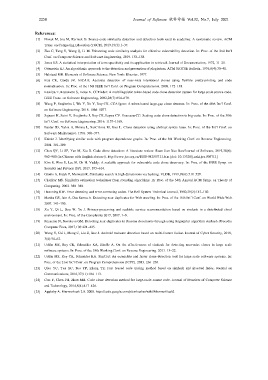Page 340 - 《软件学报》2021年第7期
P. 340
2258 Journal of Software 软件学报 Vol.32, No.7, July 2021
References:
[1] Novak M, Joy M, Kermek D. Source-code similarity detection and detection tools used in academia: A systematic review. ACM
Trans. on Computing Education (TOCE), 2019,19(3):1–37.
[2] Zhu C, Tang Y, Wang Q, Li M. Enhancing code similarity analysis for effective vulnerability detection. In: Proc. of the 2nd Int’l
Conf. on Computer Science and Software Engineering. 2019. 153–158.
[3] Jones KS. A statistical interpretation of term specificity and its application in retrieval. Journal of Documentation, 1972, 11–21.
[4] Ottenstein KJ. An algorithmic approach to the detection and prevention of plagiarism. ACM SIGCSE Bulletin, 1976,8(4):30–41.
[5] Halstead MH. Elements of Software Science. New York: Elsevier, 1977.
[6] Roy CK, Cordy JR. NICAD: Accurate detection of near-miss intentional clones using flexible pretty-printing and code
normalization. In: Proc. of the 16th IEEE Int’l Conf. on Program Comprehension. 2008. 172–181.
[7] Kamiya T, Kusumoto S, Inoue K. CCFinder: A multilinguistic token-based code clone detection system for large scale source code.
IEEE Trans. on Software Engineering, 2002,28(7):654–670.
[8] Wang P, Svajlenko J, Wu Y, Xu Y, Roy CK. CCAligner: A token based large-gap clone detector. In: Proc. of the 40th Int’l Conf.
on Software Engineering. 2018. 1066–1077.
[9] Sajnani H, Saini V, Svajlenko J, Roy CK, Lopes CV. SourcererCC: Scaling code clone detection to big-code. In: Proc. of the 38th
Int’l Conf. on Software Engineering. 2016. 1157–1168.
[10] Baxter ID, Yahin A, Moura L, Sant’Anna M, Bier L. Clone detection using abstract syntax trees. In: Proc. of the Int’l Conf. on
Software Maintenance. 1998. 368–377.
[11] Krinke J. Identifying similar code with program dependence graphs. In: Proc. of the 8th Working Conf. on Reverse Engineering.
2001. 301–309.
[12] Chen QY, Li SP, Yan M, Xia X. Code clone detection: A literature review. Ruan Jian Xue Bao/Journal of Software, 2019,30(4):
962–980 (in Chinese with English abstract). http://www.jos.org.cn/1000-9825/5711.htm [doi: 10.13328/j.cnki.jos.005711]
[13] Kim S, Woo S, Lee H, Oh H. Vuddy: A scalable approach for vulnerable code clone discovery. In: Proc. of the IEEE Symp. on
Security and Privacy (SP). 2017. 595–614.
[14] Gionis A, Indyk P, Motwani R. Similarity search in high dimensions via hashing. VLDB, 1999,99(6):518–529.
[15] Charikar MS. Similarity estimation techniques from rounding algorithms. In: Proc. of the 34th Annual ACM Symp. on Theory of
Computing. 2002. 380–388.
[16] Hamming RW. Error detecting and error correcting codes. The Bell System Technical Journal, 1950,29(2):147–160.
[17] Manku GS, Jain A, Das Sarma A. Detecting near-duplicates for Web crawling. In: Proc. of the 16th Int’l Conf. on World Wide Web.
2007. 141–150.
[18] Xu Y, Qi L, Dou W, Yu J. Privacy-preserving and scalable service recommendation based on simhash in a distributed cloud
environment. In: Proc. of the Complexity 2017. 2017. 1–9.
[19] Rezaeian N, Novikova GM. Detecting near-duplicates in Russian documents through using fingerprint algorithm simhash. Procedia
Computer Ence, 2017,103:421–425.
[20] Wang Y, Cai J, Meng C, Liu Z, Xue J. Android malware detection based on multi-feature fusion. Journal of Cyber Security, 2018,
3(4):54–62.
[21] Uddin MS, Roy CK, Schneider KA, Hindle A. On the effectiveness of simhash for detecting near-miss clones in large scale
software systems. In: Proc. of the 18th Working Conf. on Reverse Engineering. 2011. 13–22.
[22] Uddin MS, Roy CK, Schneider KA. SimCad: An extensible and faster clone detection tool for large scale software systems. In:
Proc. of the 21st Int’l Conf. on Program Comprehension (ICPC). 2013. 236–238.
[23] Qiao YC, Yun XC, Tuo YP, Zhang YZ. Fast reused code tracing method based on simhash and inverted index. Journal on
Communications, 2016,37(11):104–113.
[24] Guo Y, Chen FH, Zhou MH. Code clone detection method for large-scale source code. Journal of Frontiers of Computer Science
and Technology, 2014,8(4):417–426.
[25] Appleby A. Murmurhash 2.0. 2008. http://code.google.com/p/smhasher/wiki/MurmurHash2

